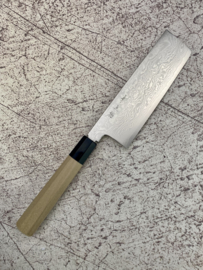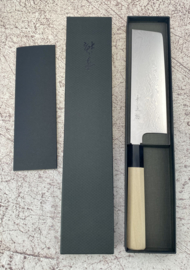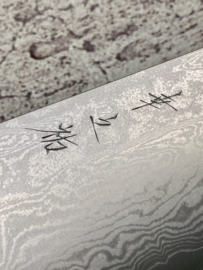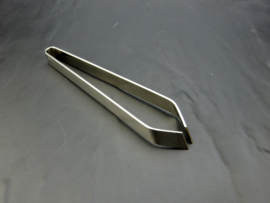Konosuke Suminagashi VG-10 Wa-Nakiri (vegetable knife), 180 mm - Octagonal Honoki - Saya
Konosuke Wa-Nakiri Damascus VG-10, 180mm,
Double-sided sharpened blade with a core of rust-resistant Japanese VG-10 steel. As protection, the core layer is forged with a damascus steel outer layer. The blade is extremely thin and manually sharpened and has no thickenings, which makes sharpening very easy. The handle is octagonal and made of natural Japanese Honoki wood with black buffalo horn bolster. (Suitable for both right and left hand use).
- Blade length: 180 mm
- Total length: 320mm
- Weight: 172 grams
- Blade thickness: 2.75 mm (max.)
- Blade height: 5.3 cm
- Steel type: Japanese VG-10 steel (rust resistant) with damascus steel outer layer (suminagashi).
- Hardness: 60-61 (Rockwell C)
- Handle: Traditional octagonal handle. Made of Honoki wood with buffalo horn bolster.
- This knife comes with a matching honoki wooden saya with Konosuke logo.
Details: Konosuke knives are available in a very limited edition. The knives are always produced in small batches. The polishing and grinding is done by various craftsmen who work exclusively for Konosuke. The level of finishing and grinding is incomparable. The Konosuke knives are among the best knives in the world and are real collector's items.
Like all Japanese knives, the Konosuke knives are not dishwasher safe, cleaning and drying after each use is the best treatment for these exclusive products.
Cutting techniques for a nakiri
Chopping is a cutting technique that is mainly used for leafy vegetables, herbs and softer vegetables (such as cucumber, mushroom, zucchini and pickle). The technique is characterized by the fact that the knife comes completely free from the cutting board when cutting.
This makes it a form of chopping and is always done at high speed. The technique requires a lot of practice and a razor-sharp knife.
- Stand straight in front of the cutting board, standing firmly on 2 legs with shoulders back.
- Grasp the knife as if you were shaking someone's hand. Keep the blade in line with your forearm when cutting.
- Let the blade go straight down while cutting. Move the knife along the phalanges of the non-cutting hand.
- Cut quickly, pulling fingers back evenly so that the slices become evenly thick. When embossing leafy vegetables and herbs, first roll the leaves into a cigar-like shape. You can then cut these lengthwise into very fine strips.
- If a recipe states that meat or fish must be hammered, it is not the intention to cut it finely. In that case, embossing means superficially carving the meat or fish. With fish, this prevents the fish from warping or the skin cracking unsightly. Meat is slit to promote cooking and prevent shrinkage.











